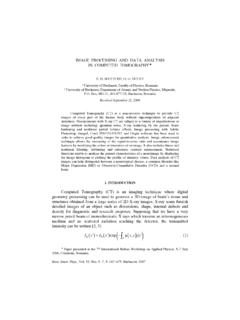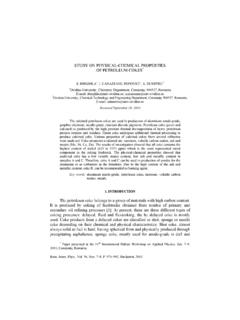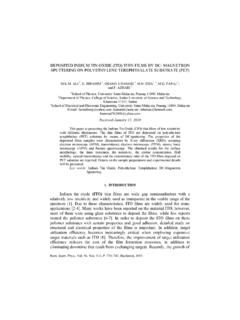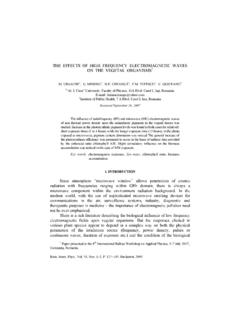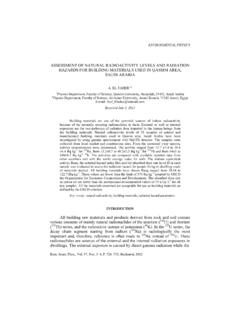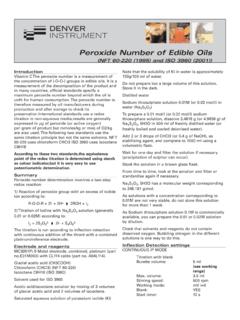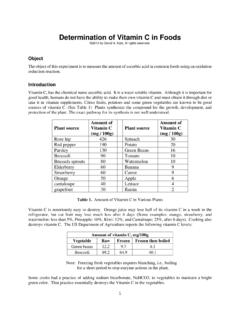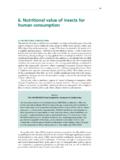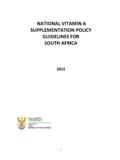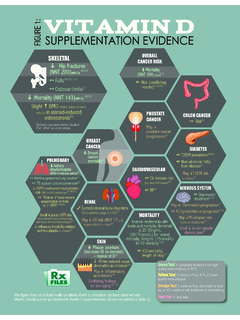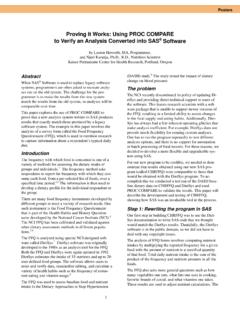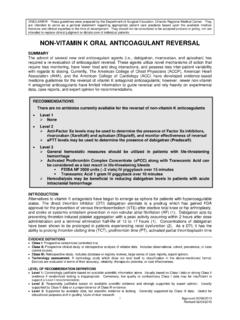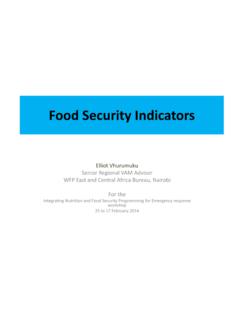Transcription of KINETIC STUDY OF VITAMIN C DEGRADATION FROM …
1 KINETIC STUDY OF VITAMIN C DEGRADATIONFROM PHARMACEUTICAL PRODUCTS N. MATEI1, S. BIRGHILA1, V. POPESCU1, S. DOBRINAS1, A. SOCEANU1, C. OPREA2,V. MAGEARU31 Department of Chemistry, Ovidius University, 124 Mamaia Blvd, Constan a 900527, Romania2 Department of Physics, Ovidius University, 124 Mamaia Blvd, Constan a 900527, Romania3 Department of Chemistry, Bucharest University, 4-12 Regina Elisabeta Blvd, Bucharest 70346,RomaniaReceived September 26, 2006 Two simple procedures for the determination of ascorbic acid ( VITAMIN C)content in a VITAMIN C tablet are proposed: conductometry and titrimetric methodwith potassium bromat-bromide solution in the acid medium. The procedures havebeen applied to the analysis of locally commercial VITAMIN C tablet samples.
2 Thevariations of VITAMIN C concentration were studied in formation of temperature. Forthe KINETIC STUDY was determinate the rate constant, the half-time and the activationenergy for VITAMIN words:conductometric and titrimetric methods, ascorbic acid, pharma-ceutical INTRODUCTIONA scorbic acid is one of the important water soluble vitamins. It is essentialfor collagen, carnitine and neurotransmitters biosynthesis. [1] Most plants andanimals synthesize ascorbic acid for their own requirement. However, apes andhumans can not synthesize ascorbic acid due to lack of an enzyme gulonolactoneoxidase. Hence, ascorbic acid has to be supplemented mainly through fruits,vegetables and tablets. [2]. The current US recommended daily allowance(RDA) for ascorbic acid ranges between 100 120 mg/ per day for adults.
3 Manyhealth benefits have been attributed to ascorbic acid such as antioxidant, anti-atherogenic, anti-carcinogenic, immunomodulator and prevents cold etc. Thus,though ascorbic acid was discovered in 17th century, the exact role of thisvitamin/nutraceutical in human biology and health is still a mystery in view ofmany beneficial claims and controversies [3].Ascorbic acid is a labile molecule; it may be lost from foods duringcooking/processing even though it has the ability to preserve foods by virtue of Paper presented at the National Conference on Applied Physics, June 9 10, 2006, Gala i,RomaniaRom. Journ. Phys., Vol. 53, Nos. 1 2 , P. 343 351, Bucharest, 2008344N. Matei et reducing property. Syntethis ascorbic acid is available in a wide variety ofsupplements, tablets, capsules, chewable tablets, crystalline powder, effervescenttablets and liquid acid (C6H8O6) is the trivial name of VITAMIN C.
4 The chemicalname is 2-oxo-L-threo-hexono-1, 4-lactone-2, 3-endiol, Fig. 1 [4].Ascorbic acid being a water soluble compound is easily absorbed but it isnot stored in the body. The major metabolites of ascorbic acid in human aredehydroascorbic acid, 2, 3-diketogluconic acid and oxalic acid, Fig. main route of elimination of ascorbic acid and its metabolites isthrough urine. It is excreted unchanged when high doses of ascorbic acid areconsumed. Ascorbic acid is generally non-toxic but at high doses (2-6g/day) itcan cause gastrointestinal disturbances or diarrhea [5, 6].Fig. 1 VITAMIN C 2 Catabolism of ascorbic in view its importance, the analysis of food products and pharma-ceuticals containing this VITAMIN assumes attempts to quantify ascorbic acid in these samples have resulted in alarge number of methods: titrimetry, voltametry, fluorometry, potentiometry, KINETIC -based chemiluminiscence (CL), flow injection analyses and chromato-graphy [7 9].
5 2. EXPERIMENTALFor determination of ascorbic acid were used two methods: a titrimetricmethod with potassium brommat-bromide solution in the acid medium [2] and aconductometric method [1] based by the calibration curve which was plottedunder the fallowing operative conditions: 4 C, 18 C, 30 C and 40 C, thelinearity range is 0,008 0,1N ascorbic C degradation345 The methods have been applied to many samples to determine the VITAMIN Cquantity at different temperature [10]. REAGENTSAll reagents were of analytical-reagent grade and all solutions wereprepared using distilled-deionized stock standard aqueous ascorbic acid solution (0,1N) was prepared fromL-ascorbic acid (Merck). Other standard ascorbic acid solutions were obtainedby appropriate dilutions of the stock the titrimetric method, the reagents used have been: Na2S2O3 0,1N,KBrO3-KBr 0,05N, K2Cr2O7 0,1N, H2SO4 1N, H2SO4 1:2, KI, starch indicator 1%.
6 APARATUSFor conductometric procedure was used a Conductivity Meter WTW, LF340-A/SET, made in CONDUCTOMETRY PROCEDUREF irst was plotted the calibration graph (Fig. 3) of different ascorbic acidconcentrations (0,008N; 0,01N; 0,03N; 0,05N; 0,08N respectively 0,1N) at theroom temperature by reading it at the conductivity meter ( S/cm).Fig. 3 The calibration graph from ascorbic TITRIMETRY PROCEDUREA scorbic acid, C6H8O6 is cleanly oxidized to dehydroascorbic acid bybromine:346N. Matei et unmeasured excess of potassium bromide is added to an acidifiedsolution of the sample. The solution is titrated with standard potassium bromateto the first permanent appearance of excess bromine: this excess is then deter-mined iodometrically with standard sodium thiosulfate.
7 The entire titration mustbe performed without delay to prevent air-oxidation of the ascorbic acid. [2, 10] KINETIC STUDYFor the KINETIC STUDY was determinate the rate constant, the half-time andthe activation energy for VITAMIN rate constant it was applied the formula:2,303logaktax= where:k = the rate constant;t = the interval of time since the reaction has began;a = the initial concentration at 18 C;a x = the concentration at different temperatures (30 C and 40 C).Arrhenius noted that the k(T) data for many reactions fit the equation:EaRTkAe = (*)where A and Ea are constants characteristic of the reaction and R is the gasconstant. Ea is the activation energy and A is the pre-exponential factor or theArrhenius factor.
8 The units of A are the same of those of k. Ea is usuallyexpressed in kcal/mol or logs of equation (*), we get:lnlnaEkART= For two different temperatures (30 C and 40 C) it was determinate thevalues for activation the Arrhenius equation is obeyed, a plot of logk versus 1/T is a straightline with slope and intercept logA. This allows Ea and A to be C degradation347 Also it was determinate the values of half-time using the equation:1/ time required for concentration of the reactant to drop to half its valueis called the reaction s half-time or half-life (t1/2). ANALYSIS OF SAMPLESV arious VITAMIN C tablet samples, commercially available locally, wereanalyzed. The samples were: standard ascorbic acid solution (Merck), VITAMIN C200 mg tablets, Ascovit 100 mg tablets with orange taste and VITAMIN C nosedrops 10%.
9 Twenty tablets were weighed and an average weight of a tablet wascalculated before being ground into fine powder. A portion of the powder,equivalent to the average weight of a tablet was dissolved in water and filteredbefore making a volume of 50 mL. Appropriate dilution may be required. Theascorbic acid liquid form was diluted. The samples were analyzed by RESULTS AND DISCUSSIONA nalyses of locally commercially available VITAMIN C tablets are summa-rized in Tables 1 and 2. The results obtained from conductometry proceduresagree with the titrimetric analysis. No significant change in the response wasobtained from other ingredients in nominal amounts (reducing sugars (sucrose(30 mg) and lactose (30 mg)), and stearate salts (10 mg as calcium-or magne-sium-salt) in a tablet).
10 Table 1 The results obtained from conductometry methodsSampleTemperature [ C] Conductometric procedure [gAA/l] Recovery [%] ascorbic (AA) by C (200 mg) 1 (continued)SampleTemperature [ C] Conductometric procedure [gAA/l] Recovery [%] tablet (100 mg) orange C nose (10%) 2 The results obtained with volumetric methodSampleTemperature [ C] Titrimetric procedure [gAA/L] Recovery [%] ascorbic C (200 mg) tablet (100 mg) orange C nose (10%) 4 Ascorbic acid 5 VITAMIN C tablet (200 mg).Fig. 6 Ascovit tablet (100 mg) with orange taste. Fig. 7 VITAMIN C (10%) nose Matei et Table 3 are presented the values for the rate constants determinate at30 C and 40 C for all types of VITAMIN can observe that the rate constants depend strongly on temperature,typically increasing rapidly with increasing Table 4 are present the values of activation energy analytical and 3 The values for the rate constantsTypesThe rate constant k [s 1]of VITAMIN CAt 30 CAt 40 CStandard ascorbic acid solution (Merck) 10 10 4 VITAMIN C 200 mg 10 10 3 Ascovit 100 mg 10 10 4 VITAMIN C nose 10 10 4 Table 4 Activation energy by analytical and graphicalTypesActivation energy Ea [kcal/mol]of VITAMIN CAnalyticalGraphicalStandard ascorbic acid solution (Merck)

